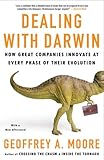Not all innovation is innovative enough
This month I’m working on a generalized paper on open and user innovation, a follow up to the encouragement I received for my talk at the User and Open Innovation Conference last august at Harvard. While doing the research for the paper, I found an interesting juxtaposition of two sources with the same argument: don’t bother with half-hearted innovation. The first reference was in Geoff Moore’s Dealing with Darwin. Since I reviewed the book two years ago, I have been a big fan of the book. As I said in the review:
The first reference was in Geoff Moore’s Dealing with Darwin. Since I reviewed the book two years ago, I have been a big fan of the book. As I said in the review:
Certainly his most ambitious book yet, Dealing with Darwin, uses his consulting practice — with a special emphasis on Cisco — to offer nothing less than a grand unified theory of product and service innovation. While academics may be skeptical absent peer reviewed statistical tests, Moore appears to offer a complete framework for innovation that is both mutually exclusive and exhaustive. The hubris is stunning, even by business best-seller standards: still the integration is novel, as are many of the concepts.Since that time, I’ve used it in every section of my MBA technology strategy class. The students find it approachable and useful, even if (as always) they rebel at the idea of reading an entire book (even if spread across two weeks).
One of the first ideas I use from the book is his proclamation in the first chapter (pp. 5-8) that if innovation is intended to support a differentiation strategy, it must be enought to “achieve separation” in the minds of a buyer. Without differentiation (as regular readers of this blog know), the alternative is commodization, competing on price and plummeting profit margins. Moore concludes that desirable innovation outcomes are either differentiating, neutralizing the differentiation of a rival, or improving productivity (i.e. cost reducing).
However, he argues, a majority of innovation spending is wasted, because they achieve none of these three. The “pernicious” examples of waste including neutralization efforts that overspend by adding “nice-to-have enhancements” that are not necessary for neutralization. Conversely, other efforts underperform, by spending heavily to create differentiation but that is not enough to achieve it.
As a (now timely) example, he mentions the fate of America’s biggest auto maker:
This is a horrible outcome. In effect, you have spent the resources for differentiation but have achieved the outcomes o neutralization. … You are sliding down a hazardous commoditization curve, and if you do not do something drastic in fairly short order, you will find yourself stuck at the bottom of the hill, with neither the energy nor the funds to get yourself back to the top.We covered Moore’s book last month in my tech strategy class. This morning, while looking for more general innovation resources, I rediscovered a famous 1991 paper on new product development by Elko Kleinschmidt and Bob Cooper. To quote from the abstract:
This has been the fate of the Chevrolet division of General Motors [and other firms]… It is not that these companies do not innovate. It is that their offers do not achieve separation — and here is the kicker — they were never designed to!
Picture in your mind a Chevrolet sedan from the past ten years. Just try. Nothing? That’s my point. … Innovation for differentiation must be bold enough that, if it wins, it achieves separation. That’s why Chrysler’s failures are more memorable than Chevrolet’s successes— the Viper and the Prowler, for two.
While many writers and strategists maintain that innovation is important, research has often demonstrated that product innovativeness does not have a major impact on the rate of success in the marketplace. Elko Kleinschmidt and Robert Cooper demonstrate that the relationship between product innovativeness and commercial success is U-shaped. That means that both high and low innovativeness products are more likely to be more successful than those in-between. The authors suggest that past research has not allowed for this non-linear relationship and that their data show that moderately innovative, middle-of-the-road products are less likely to succeed when measured by a number of performance criteria.So across two decades of academic and consultant study of innovation is evidence supporting a rather simple idea: innovate enough to make a difference to your buyers, or don’t bother.

![[feed]](http://photos1.blogger.com/x/blogger2/6971/993546936938810/1600/z/962294/gse_multipart3851.gif)

No comments:
Post a Comment